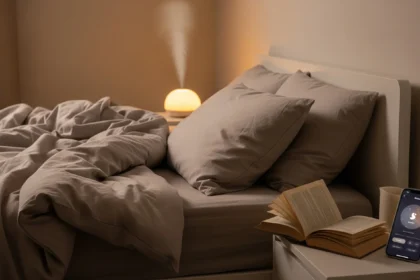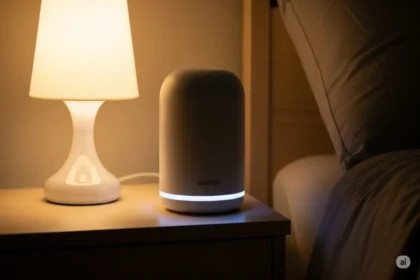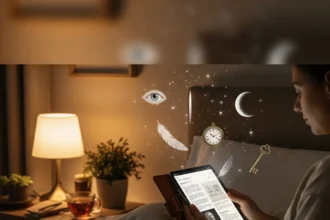The world is perpetually buzzing, a relentless symphony of notifications, deadlines, and the ever-present hum of productivity. It’s no wonder that, for many, the simple act of falling asleep has become an Olympic sport, fraught with mental gymnastics and desperate pleas to the Sandman. Whether you’re in the bustling metropolises of America or the charming cobbled streets of Europe, the quest for truly restorative slumber is a shared human endeavor. Yet, despite cultural differences, some universal truths about sleep emerge. Through countless conversations with sleep experts, researchers, and everyday individuals on both continents, a pattern of highly effective habits has come to light. These aren’t just old wives’ tales; they’re strategies rooted in science, tried and tested, offering a beacon of hope for weary souls. So, let’s pull back the covers and explore the Top 5 Sleep Hacks that people on both sides of the Atlantic swear by.
1. The Undeniable Power of a Consistent Sleep Schedule (The Circadian Champion)
If there’s one piece of advice that echoes across every sleep clinic and wellness blog, it’s this: go to bed and wake up at the same time every single day, even on weekends. This might sound rigid, even a little boring, but it’s the single most potent tool for optimizing your body’s natural sleep-wake cycle, known as the circadian rhythm.
- The Science: Our bodies thrive on routine. The suprachiasmatic nucleus (SCN) in our brain, often called the “master clock,” is highly sensitive to regularity. When you adhere to a consistent sleep schedule, you train your SCN to anticipate sleep and wakefulness. This leads to a more predictable release of melatonin (the sleep hormone) in the evening and cortisol (the wakefulness hormone) in the morning. Disrupting this rhythm, often referred to as “social jet lag” on weekends, can throw your entire system out of whack, leading to fragmented sleep, daytime fatigue, and even long-term health issues. Research consistently shows that sleep consistency is often more crucial than the sheer amount of sleep you get. A 2024 study involving billions of sleep measurements across 68 countries indicated that higher nighttime temperatures negatively impact sleep, and consistency helps mitigate some risks. Another study highlighted that maintaining consistent sleep times benefits cardiovascular health more than just total hours of sleep.
- Real-world Insight: Across the U.S. and Europe, where work schedules can be demanding, those who manage to carve out and protect their sleep window report profound differences. Consider John, a software engineer in Silicon Valley, who used to burn the midnight oil and “catch up” on sleep on Saturdays. He perpetually felt foggy. Once he committed to a strict 10 PM bedtime and 6 AM wake-up, seven days a week, his energy levels soared, and his focus sharpened. Similarly, in Germany, where punctuality and routine are often valued, many embrace a steadfast sleep schedule, seeing it as essential for overall well-being. It’s about respecting your internal clock as much as you respect your external commitments.
2. Dimming the Lights: The Essential Role of Darkness (Melatonin’s Best Friend)
In our modern, electrified world, we are constantly bathed in light, long after the sun has set. This pervasive artificial glow, particularly the blue light emitted from screens, is a primary saboteur of natural sleep.
- The Science: Light is the most powerful external cue for our circadian rhythm. When light hits specialized photoreceptor cells in our eyes, it sends a signal to the SCN, which in turn suppresses the production of melatonin. Blue light, specifically, is the most effective at doing this. Even moderate room light before bedtime can significantly suppress melatonin onset and shorten its duration, tricking your body into believing it’s still daytime. This makes it harder to fall asleep and reduces the depth of your sleep. Studies have shown that just two hours of evening light exposure can cause a significant circadian phase delay.
- Real-world Insight: This hack is universally embraced by sleep-conscious individuals. In Sweden, known for its long, dark winters and appreciation for hygge (coziness), dimming lights and creating warm, inviting evening atmospheres is second nature. Americans, increasingly aware of screen time’s impact, are adopting “digital detoxes” before bed. Maria, a professor in Barcelona, used to scroll through her tablet until her eyes burned. Now, an hour before bed, she switches to a physical book under a soft, amber-toned lamp. “The difference is astonishing,” she says. “My mind slows down, and I actually feel sleepy, not just tired.” This isn’t about living in darkness all evening, but about consciously transitioning to lower, warmer light levels to signal to your body that night is approaching.
3. The Cold Truth: Optimizing Your Bedroom Temperature (The Thermoregulatory Tweak)
Our bodies are exquisitely designed to cool down as we prepare for sleep. A too-warm bedroom can wage war against this natural physiological process, making restful sleep a distant dream.
- The Science: As part of your circadian rhythm, your core body temperature naturally drops by about 1-2 degrees Celsius (2-3 degrees Fahrenheit) in the hours before sleep. This drop is a key signal for sleep onset and helps you maintain deeper sleep stages. If your sleeping environment is too warm, it hinders this natural cooling process, leading to increased wakefulness and reduced slow-wave (deep) sleep and REM sleep. Research suggests an ideal sleep temperature range of 15-19°C (60-67°F) for optimal rest. While individual preferences vary, most people sleep better in a slightly cooler room.
- Real-world Insight: Whether it’s the air-conditioned comfort sought in American summers or the preference for open windows in cooler European climates, people who prioritize sleep understand temperature’s role. Many, like Thomas from Berlin, swear by keeping their bedroom windows ajar even in cooler weather, bundling up with a duvet for warmth. “The fresh, cool air just makes the room feel so much more inviting for sleep,” he explains. Others utilize fans, smart thermostats, or even specialized cooling mattresses to maintain their ideal “sleep cave” temperature. It’s about creating an environment where your body can effortlessly shed heat, allowing you to drift into deeper, more restorative slumber.
4. The Mind-Body Connection: Embracing Mindfulness and Relaxation Techniques (The Mental Unwind)
Beyond the physical environment, our mental state plays a colossal role in our ability to fall and stay asleep. In both high-stress American work culture and the sometimes equally demanding European pace, quieting a racing mind before bed is a shared challenge.
- The Science: Stress and anxiety are potent antagonists of sleep. When we’re stressed, our sympathetic nervous system (the “fight or flight” response) is activated, leading to increased heart rate, elevated cortisol levels, and a state of hyperarousal that is incompatible with sleep. Mindfulness and relaxation techniques, such as meditation, deep breathing exercises, or gentle yoga, activate the parasympathetic nervous system (the “rest and digest” response). This shift promotes physiological calm, reducing heart rate, lowering blood pressure, and quieting the mental chatter that often keeps us awake. Studies show that mindfulness meditation can improve sleep quality, reduce insomnia symptoms, and even influence brain activity towards more slow-wave sleep.
- Real-world Insight: The adoption of mindfulness practices before bed has surged across continents. From guided meditation apps that are popular in the U.S. to the growing embrace of yoga and tai chi in European cities, people are discovering the power of a mental “wind-down.” Olivia, a student in London, found her mind constantly replaying the day’s events. She began a 10-minute guided meditation before bed, focusing on her breath. “It doesn’t always make me fall asleep instantly,” she admits, “but it stops the endless loop of thoughts and allows me to relax enough to eventually drift off.” This hack isn’t about forced sleep but about creating the optimal mental landscape for sleep to naturally arrive.
5. The Timeless Ritual: Reading a Physical Book (The Digital Detox Alternative)
In an age dominated by glowing screens, the simple, ancient act of reading a physical book before bed is a hack that resonates powerfully with sleep advocates.
- The Science: This ties closely into the “dimming the lights” principle. Unlike tablets or smartphones, physical books emit no blue light, thus avoiding the suppression of melatonin. Furthermore, reading a captivating story or engaging with non-stimulating content provides a mental escape. A 2009 study by the University of Sussex found that reading for just six minutes could reduce stress levels by 68%, proving more effective than listening to music or taking a walk. It engages your mind just enough to distract from daily worries, without overstimulating it. This gentle cognitive engagement helps transition the brain from an active, problem-solving state to a more relaxed, receptive one, preparing it for sleep.
- Real-world Insight: Many Americans and Europeans cherish their pre-bed reading ritual. In cozy Dutch homes, you might find someone engrossed in a novel, while in a quiet corner of a French apartment, another dives into poetry. Sarah, a marketing professional from New York, replaced her nightly social media scroll with a chapter from a fantasy novel. “It’s like a warm bath for my brain,” she muses. “I get lost in another world, and suddenly, my own worries fade, and I’m genuinely tired.” This isn’t just a habit; it’s a conscious choice to disengage from the hyper-connected world and reconnect with a timeless, soothing activity.
Ultimately, the quest for optimal sleep is a deeply personal journey, influenced by individual biology, lifestyle, and environment. While pharmaceutical solutions may offer temporary relief, the true mastery of sleep often lies in aligning with our body’s innate wisdom. These top sleep hacks, championed by individuals across continents and validated by science, offer a powerful framework. They remind us that sleep isn’t a luxury, but a fundamental pillar of health, well-being, and a vibrant life. Perhaps tonight, as you prepare for bed, you might try one of these tried-and-true strategies. You might just discover the profound, restorative sleep you’ve been dreaming of, a universal language spoken by every rested soul.
Disclaimer: The information provided in this article is for general informational purposes only and does not constitute medical advice. It is not a substitute for professional medical advice, diagnosis, or treatment. Always seek the advice of your physician or other qualified health provider with any questions you may have regarding a medical condition. Never disregard professional medical advice or delay in seeking it because of something you have read on this website.














